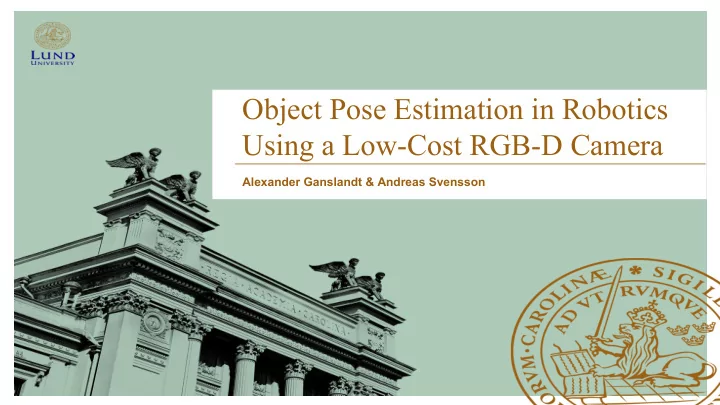

Object Pose Estimation in Robotics Using a Low-Cost RGB-D Camera Alexander Ganslandt & Andreas Svensson
Background ● Picking up an object in a structured and predefined environment is no match for today’s industrial robots ● The task becomes more cumbersome when the objects are moved by e.g. a human operator ● With today's increasing demand for human-robot interaction and cooperation, the robot needs to be able to adapt to unstructured environments
Problem ● Can we estimate the pose of an object i.e. position and rotation using an RGB-D camera? ● How accurately can we measure the pose of the object? ● Can we transform the pose estimation into the robot’s coordinate reference system?
Contents ● Basics ○ RGB-D Camera Introduction ○ Point Clouds and Point Cloud Library ● Project Description and Results ○ Constructing Point Cloud Models ○ Object Pose Estimation ○ Connecting to a Robot ● Future Work and Conclusion
RGB-D Camera Introduction ● RGB camera + Depth sensor 2.5 D ● Time-of-Flight (laser, phase-shift) ● Passive triangulation ● Active triangulation (structured light)
Intel RealSense SR300 ● Small RGB-D camera using structured light ● Low-cost (around $149) ● Uses Intel RealSense SDK with lots of examples ● Poor and incomplete documentation
Point Cloud ● Set of data points in 3D ● Can contain color information
Point Cloud Library (PCL) ● Library for 2D/3D image and point cloud processing ● Large scale, open source and cross-platform ○ Well written documentation ○ Great tutorials ○ Supports many point cloud formats (PCD OBJ PLY) ● Written in C++ ○ Some support for Visual Studio (2008 and 2010)
Constructing Point Cloud Models • We need a 3D model of the object for the pose estimation • Achieved by segmentation and merging point clouds from different views
Constructing Point Cloud Models
Constructing Point Cloud Models Segmentation ● RANSAC to find and remove plane ● Euclidean Cluster Extraction to extract point cloud of object
Constructing Point Cloud Models Random sample consensus (RANSAC) ● Mainly used as an outlier detector ● RANSAC to remove a plane: ○ Equation of a plane: ax + by + cz + d = 0 ○ Inliers are points in a close proximity of the plane ○ Find the set of inliers to the plane and remove them
Constructing Point Cloud Models Euclidean Cluster Extraction ● Searches for the set of neighbors of a point that are within a sphere ● Uses a Kd-tree structure for finding the nearest neighbors
Constructing Point Cloud Models
Constructing Point Cloud Models Pairwise registration ● Two consecutive segments have different rotation and translation. ● Pairwise registration tries to find the transformation between the segments ● Once the transformation has been found the point clouds are merged and smoothed.
Constructing Point Cloud Models Pairwise registration - Finding the transformation ● First a pose estimation algorithm is used to find a rough transformation using a heavily downsampled version of the segment (more on this later) ● Once a rough estimate of the transformation has been found an Iterative Closest Point (ICP) algorithm is used to get a better estimate using the full size of the sample set ● The point cloud in the second image is then transformed to match the point cloud in the first image
Constructing Point Cloud Models Iterative Closest Point (ICP) ● Used to minimize the distance between two point clouds. ● Achieved by estimating a rotation R and translation t ● This is done by minimizing a cost function: ● Convergence is improved if the point clouds are initially close
Constructing Point Cloud Models
Final Point Cloud Model
Final Point Cloud Model ● Extracted model is far from perfect ○ Hard to achieve a true 3D model of symmetric objects ● Alternatively: ○ Create and use a CAD model of the object ○ Use 3D-scanning software (price) ○ Reconstruct the 3D image by using the RGB images ■ Extract matching features and use triangulation
Object Pose Estimation ● We want to estimate 6-DoF ○ Position of object (3-DoF) ○ Rotation of object (3-DoF)
Pipeline - Input
Pipeline - Downsample
Pipeline - Remove largest plane
Pipeline - Extract clusters
Pipeline - Estimate normals
Pipeline - Estimate features ● Encode a points geometrical properties ● We use Fast Point Feature Histograms (FPFH) ○ Looks at the k-neighborhood of each point ○ Computes features based on direction of normals ● Many different point feature representations available ○ Viewpoint Feature Histogram (2010) ○ Color Point Pair Feature (2015)
Pipeline - Estimate pose
Pipeline - Estimate pose
Pipeline - Estimate pose
Pipeline - Estimate pose
Pipeline - Estimate pose
Pipeline - Estimate pose
Pipeline - Estimate pose
Pipeline - Estimate pose
Results
Results
Connecting to a Robot ● Find transformation from camera to robot coordinate system ● Euclidean transformation ○ Need at least 3 points expressed in both coordinate systems ● Could be done automatically using pose estimation ● Could also directly estimate pose of robot if it is visible
Problem ● Can we estimate the pose of an object i.e. position and rotation using an RGB-D camera? ● How accurately can we measure the pose of the object? ● Can we translate the pose estimation into the robot’s coordinate reference system?
Future Work ● Autonomous robot-camera calibration ● Using RGB data in features ● Estimating pose for multiple identical objects ● Using multiple RGB-D cameras to avoid occlusions
Thank you for listening! Questions?
Recommend
More recommend